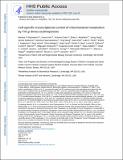Cell-specific transcriptional control of mitochondrial metabolism by TIF1γ drives erythropoiesis
Author(s)
Rossmann, Marlies P; Hoi, Karen; Chan, Victoria; Abraham, Brian J; Yang, Song; Mullahoo, James; Papanastasiou, Malvina; Wang, Ying; Elia, Ilaria; Perlin, Julie R; Hagedorn, Elliott J; Hetzel, Sara; Weigert, Raha; Vyas, Sejal; Nag, Partha P; Sullivan, Lucas B; Warren, Curtis R; Dorjsuren, Bilguujin; Greig, Eugenia Custo; Adatto, Isaac; Cowan, Chad A; Schreiber, Stuart L; Young, Richard A; Meissner, Alexander; Haigis, Marcia C; Hekimi, Siegfried; Carr, Steven A; Zon, Leonard I; ... Show more Show less
DownloadAccepted version (1.432Mb)
Open Access Policy
Open Access Policy
Creative Commons Attribution-Noncommercial-Share Alike
Terms of use
Metadata
Show full item recordAbstract
Transcription and metabolism both influence cell function, but dedicated transcriptional control of metabolic pathways that regulate cell fate has rarely been defined. We discovered, using a chemical suppressor screen, that inhibition of the pyrimidine biosynthesis enzyme dihydroorotate dehydrogenase (DHODH) rescues erythroid differentiation in bloodless zebrafish moonshine (mon) mutant embryos defective for transcriptional intermediary factor 1 gamma (tif1γ). This rescue depends on the functional link of DHODH to mitochondrial respiration. The transcription elongation factor TIF1γ directly controls coenzyme Q (CoQ) synthesis gene expression. Upon tif1γ loss, CoQ levels are reduced, and a high succinate/α-ketoglutarate ratio leads to increased histone methylation. A CoQ analog rescues mon's bloodless phenotype. These results demonstrate that mitochondrial metabolism is a key output of a lineage transcription factor that drives cell fate decisions in the early blood lineage.
Date issued
2021Department
Whitehead Institute for Biomedical Research; Massachusetts Institute of Technology. Department of BiologyJournal
Science
Publisher
American Association for the Advancement of Science (AAAS)